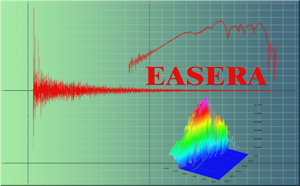Three-way Omnidirectional Sound Source
In effort to create a very controlled measurement setup, an omnidirectional sound source was constructed for room impulse response measurements, providing a control source with a known directivity pattern. While commercially available omnidirectional sound sources exist, most become directional at mid to high frequencies, around 1 or 2 kHz, and cannot achieve accurate signal-to-noise ratios due to lack of low frequency performance.
To overcome both of these problems, a three-way source was built by Dave Dick, with the help of Andrew Coward. The three way source allows for omni-directional room measurements from below 20 Hz up to 5000 Hz. This enables a much higher bandwidth in comparable measurements made between rooms, allowing for a repeatable and robust measurement setup. More information about this source can be found on the project page here.
Compact Spherical Loudspeaker Array
Although it is common to use a dodecahedron-style omnidirectional sound source to measure a concert hall or room, this source is not realistic to natural sound sources. Natural sources exhibit highly unique source radiation patterns, commonly referred to as directivities. These directivity functions also change quite uniquely with frequency as well. To take room impulse response measurements with realistic directivities, a 20-channel compact spherical loudspeaker array was built. This array provides 20 individually controllable driver elements, allowing for flexible, frequency-dependent control of source directivity patterns. An example of this sound source reconstructing the directivity pattern of an oboe is shown below.
SPRAL Precision Measurement Stand
The SPRAL precision measurement stand was developed by Andrew Coward (honorary SPRAL member/ mechanical technician), and it is capable of accurately position a microphone at a specific height from a chair cushion, a specific depth from a chair back, rotated to a particular direction. Using it’s robust design, each of these three variable can be adjusted independently, allowing for quick, reliable, and repeatable microphone placement when performing impulse response measurements in concert halls. In just two to four minutes, the Eigenmike and stand can be placed and ready for measurement. Check it out by watching the video below!
Eigenmike, em32 by mh acoustics
Photo from mhacoustics.com
The Eigenmike is a 32 channel spherical microphone array made by mh Acoustics. The microphone is an array of 1/2″ microphones, and through the use of spherical harmonics and beam-forming, we are able to extract a high degree of spatial information and resolution of concert hall sound fields. Through the use of higher order ambisonics, the measured sound fields can be reproduces over our 3D loudspeaker array, or our Multi-channel Loudspeaker Auralization Facility.
S.A.M., Brüel & Kjær Head and Torso Simulator (HATS)
S.A.M., or the SPRAL Acoustic Mannequin, is a Brüel & Kjær Type 4100-D Head and Torso Simulator (HATS), used for making binaural recordings or taking binaural room impulse response measurements. SAM is a valued member of SPRAL, and helps to assist us in our room acoustics measurements. These impulse response measurements can be used to create headphone based room acoustic auralizations.
Physiological Measurement Equipment
Description coming soon…
Commercial Software Licenses
ODEON Room Acoustics Simulations and Measurements software (website)
EASERA – Electronic and Acoustic System Evaluation and Response Analysis (website)
Max Visual Programming by Cycling ’74 (website) – used for creation of subjective testing interfaces and relevant audio signal processing for the AURAS facility.





